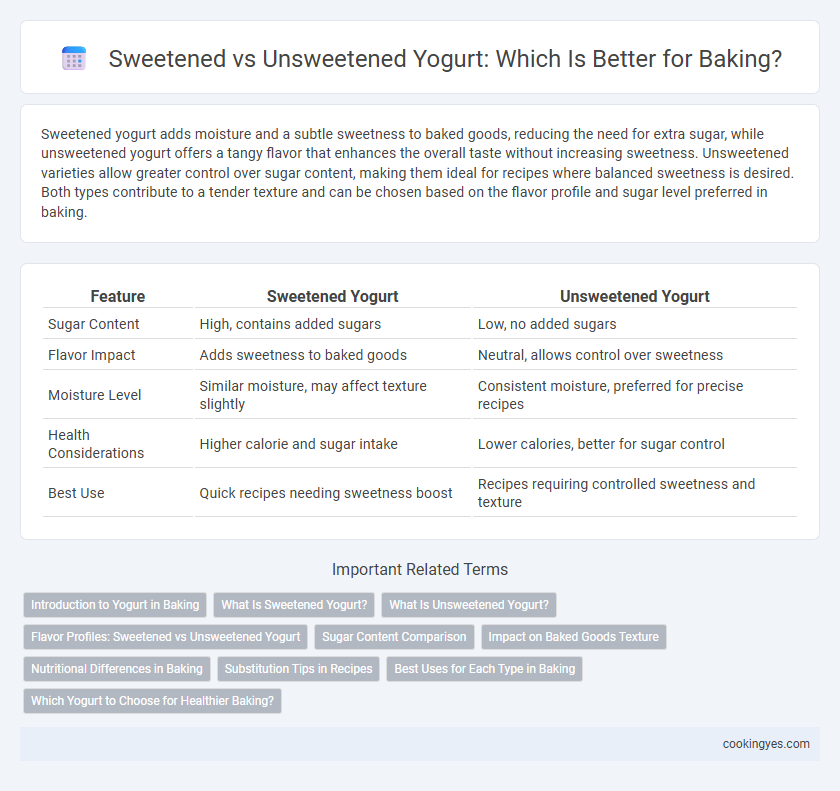Sweetened yogurt adds moisture and a subtle sweetness to baked goods, reducing the need for extra sugar, while unsweetened yogurt offers a tangy flavor that enhances the overall taste without increasing sweetness. Unsweetened varieties allow greater control over sugar content, making them ideal for recipes where balanced sweetness is desired. Both types contribute to a tender texture and can be chosen based on the flavor profile and sugar level preferred in baking.
Table of Comparison
| Feature | Sweetened Yogurt | Unsweetened Yogurt |
|---|---|---|
| Sugar Content | High, contains added sugars | Low, no added sugars |
| Flavor Impact | Adds sweetness to baked goods | Neutral, allows control over sweetness |
| Moisture Level | Similar moisture, may affect texture slightly | Consistent moisture, preferred for precise recipes |
| Health Considerations | Higher calorie and sugar intake | Lower calories, better for sugar control |
| Best Use | Quick recipes needing sweetness boost | Recipes requiring controlled sweetness and texture |
Introduction to Yogurt in Baking
Yogurt is a versatile ingredient in baking, contributing moisture, tenderness, and a subtle tangy flavor to baked goods. Sweetened yogurt adds sweetness and richness, making it ideal for desserts, while unsweetened yogurt offers control over sugar levels and enhances the natural tartness without altering the recipe's sweetness balance. The choice between sweetened and unsweetened yogurt impacts the flavor profile and texture of cakes, muffins, and breads.
What Is Sweetened Yogurt?
Sweetened yogurt contains added sugars or natural sweeteners like honey, making it a flavorful option for baked goods that require a hint of sweetness. This type of yogurt enhances moisture and tenderness in recipes such as muffins, cakes, and breads while contributing to browning during baking. Using sweetened yogurt influences the overall sugar content and may affect the texture and flavor profile of the final product.
What Is Unsweetened Yogurt?
Unsweetened yogurt is a dairy product made from fermented milk without added sugars or sweeteners, maintaining a natural tart flavor. It contains live active cultures like Lactobacillus bulgaricus and Streptococcus thermophilus, which contribute to its probiotic benefits and creamy texture. In baking, unsweetened yogurt provides moisture and acidity that helps activate leavening agents, resulting in tender, fluffy baked goods without the extra sweetness from added sugars.
Flavor Profiles: Sweetened vs Unsweetened Yogurt
Sweetened yogurt adds a rich, creamy sweetness that enhances baked goods by balancing tartness and providing a smooth texture. Unsweetened yogurt offers a tangy, slightly acidic flavor that intensifies the freshness and adds depth to recipes without extra sugar. Choosing between sweetened and unsweetened yogurt affects sweetness levels and overall flavor complexity in cakes, muffins, and breads.
Sugar Content Comparison
Sweetened yogurt contains added sugars that increase the overall sugar content in baked goods, while unsweetened yogurt has no added sugars, allowing for precise control over sweetness. Using unsweetened yogurt in baking helps reduce excess sugar, making recipes healthier and more customizable to dietary needs. High sugar content in sweetened yogurt can affect texture and caramelization in baked products, often resulting in a sweeter, softer outcome.
Impact on Baked Goods Texture
Sweetened yogurt in baking contributes moisture and a subtle sweetness, resulting in softer and more tender baked goods with a slightly caramelized crust. Unsweetened yogurt provides a tangy flavor and denser texture, promoting a firmer crumb and enhanced rise due to its acidity activating leavening agents. Choosing between sweetened and unsweetened yogurt directly affects the moisture content and texture profile of cakes, muffins, and breads.
Nutritional Differences in Baking
Sweetened yogurt contains added sugars that increase calorie content, potentially affecting the sweetness and moisture of baked goods, while unsweetened yogurt offers a lower sugar option with a tangier flavor profile. The higher sugar content in sweetened yogurt can enhance browning and contribute to a softer crumb in cakes and muffins. Nutritionally, unsweetened yogurt provides more protein and fewer carbohydrates, making it a preferable choice for health-conscious baking without compromising texture.
Substitution Tips in Recipes
When substituting sweetened yogurt for unsweetened yogurt in baking recipes, reduce added sugars to balance sweetness and avoid overly sweet results. Unsweetened yogurt provides a tangy flavor and moisture without extra sugar, making it ideal for controlling sweetness and texture. Adjust the recipe's sugar content and consider the moisture difference to maintain the desired consistency and flavor profile.
Best Uses for Each Type in Baking
Sweetened yogurt adds moisture and subtle sweetness to baked goods like muffins and cakes, enhancing flavor without needing extra sugar. Unsweetened yogurt is ideal for savory baked items or recipes where precise sugar control is crucial, such as breads and cheese-based desserts. Choosing the right yogurt depends on the desired taste profile and moisture content in recipes like quick breads, pancakes, or quiches.
Which Yogurt to Choose for Healthier Baking?
Choosing unsweetened yogurt for baking offers a healthier option by eliminating added sugars, allowing better control over overall sweetness and nutritional content in recipes. Unsweetened yogurt retains probiotics and essential nutrients like calcium and protein without the extra calories from sugar. Sweetened yogurt can increase sugar intake, potentially affecting blood sugar levels and overall health, making unsweetened varieties preferable for health-conscious bakers.
Sweetened Yogurt vs Unsweetened Yogurt for Baking Infographic

 cookingyes.com
cookingyes.com